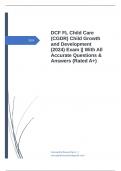DCF FL Child Care
2024 (CGDR) Child Growth
and Development
(2024) Exam || With All
Accurate Questions &
Answers (Rated A+)
Conceptial Researchers ||
conceptialresearch@gmail.com
, DCF FL Child Care (CGDR) Child
Growth and Development (2024) Exam
|| With All Accurate Questions &
Answers (Rated A+)
Principles of Child Development - ANSWER - There are five principles related to the
progression of general development that children will typically experience.
The five domains of development are.. - ANSWER - -Physical Development (PD),
-Cognitive Development and General Knowledge (CDGK),
-Language and Communication (LC),
-Social and Emotional Development. (SED), and
-Approaches to Learning. (ATL)
The characteristics of the Physical Development Domain (PD) - ANSWER - involve
increased physical growth and abilities.
There are many characteristics of the Cognitive Development and General
Knowledge Domain, and the Approaches to Learning Domain, which include -
ANSWER - thinking, planning, creating, exploring, and questioning.
The Language and Communication (LC) Domain includes - ANSWER - a child's
abilities to see, hear, speak, read, and write.
The Social and Emotional Development (SED) Domain is defined by - ANSWER -
forming relationships and attachments.
Developmental Sequence is Similar for All - ANSWER - In the Infant Care Center
this fall, you noticed four-month-old Sara roll over; a few weeks later, she began
scooting. By December, six-month-old Raul had rolled over and scooted. Last week,
you noted that Renae—at the age of five months—had rolled over, and you predict
she will be scooting very soon.
Development Proceeds from General to Specific - ANSWER - Three-month-old Sean
loves to wave his arms in the air. As you watch him, you think about the skills he will
probably achieve next: first, he will grasp objects; then he will be able to hold a
crayon; and someday, he will be able to write with a pencil.
Development is Continuous - ANSWER - When LaShanda was two, you noted that
she enjoyed solitary play and did not interact with other children. By the age of two
and a half, LaShanda liked to play next to another child, but there was no interaction
(parallel play). By the age of three, LaShanda engaged routinely in associative play
and could share common materials with another child without interaction. By three
and a half, she had made her first real friend and was capable of true cooperative
play.
, Development Proceeds at Different Rates - ANSWER - Tom and Tim are twins and
want to do everything together. However, Tom rode his tricycle with ease by his third
birthday, but Tim was almost four before he could ride his tricycle with confidence.
5 - All Areas of Development are Interrelated - ANSWER - Pete and Al, both nearly
five years old, are playing with the same puzzle. You watch as Pete tells Al, "The first
piece goes here." Al says, "We both have five pieces now." Even though the activity
lasts only a few minutes, you believe it is a good indicator of each boy's current
development.
Implications for Child Care Professionals - ANSWER - Child care professionals may
spot developmental issues before the parents do, which is why it is important to
understand the basic child growth and development principles.
Implications for Learning - ANSWER - All of your interactions with a child have an
effect on the child's development and learning, which means it is important to be
aware of what the child is learning while in your care.
Why should child care professionals learn about principles of child development? -
ANSWER - Care and the environment can support or hinder development.
The knowledgeable caregiver can support a child in learning new skills.
When a child is struggling with a new skill, timely intervention can help him/her
overcome a problem and "catch back up."
The knowledgeable caregiver can "detect" indicators of possible delays and can help
get the child the assistance he/she needs.
Developmental Sequence is Similar for All - ANSWER - Children develop in relatively
the same ways.
There is a typical sequence of development that occurs as a child grows.
While the sequence is similar, and the behaviors or skills emerge in the same order,
children can take more or less time with each behavior or skill.
They can move forward, regress for a short time, then move forward again.
Some children may skip a behavior or skill as they move forward.
2 - Development Proceeds from General to Specific - ANSWER - Development
progresses from a beginning point moving in a forward direction.
Just as growth of an infant proceeds from the top down and from the center of the
body to the limbs, development of behaviors and skills moves from general to
specific.
As children mature, their bodily changes occur in a sequential order and give
children new abilities.
As the brain and nervous system develop, a child's thinking (cognitive) skills and
motor skills improve.
In the Physical Development Domain, an infant's large muscles develop first and
result in the ability to wave the arms and kick the legs.
Development continues in the smaller muscles in the fingers and toes, and results in
the ability of the fingers to grasp objects and the toes to help with balance when
standing and walking.




